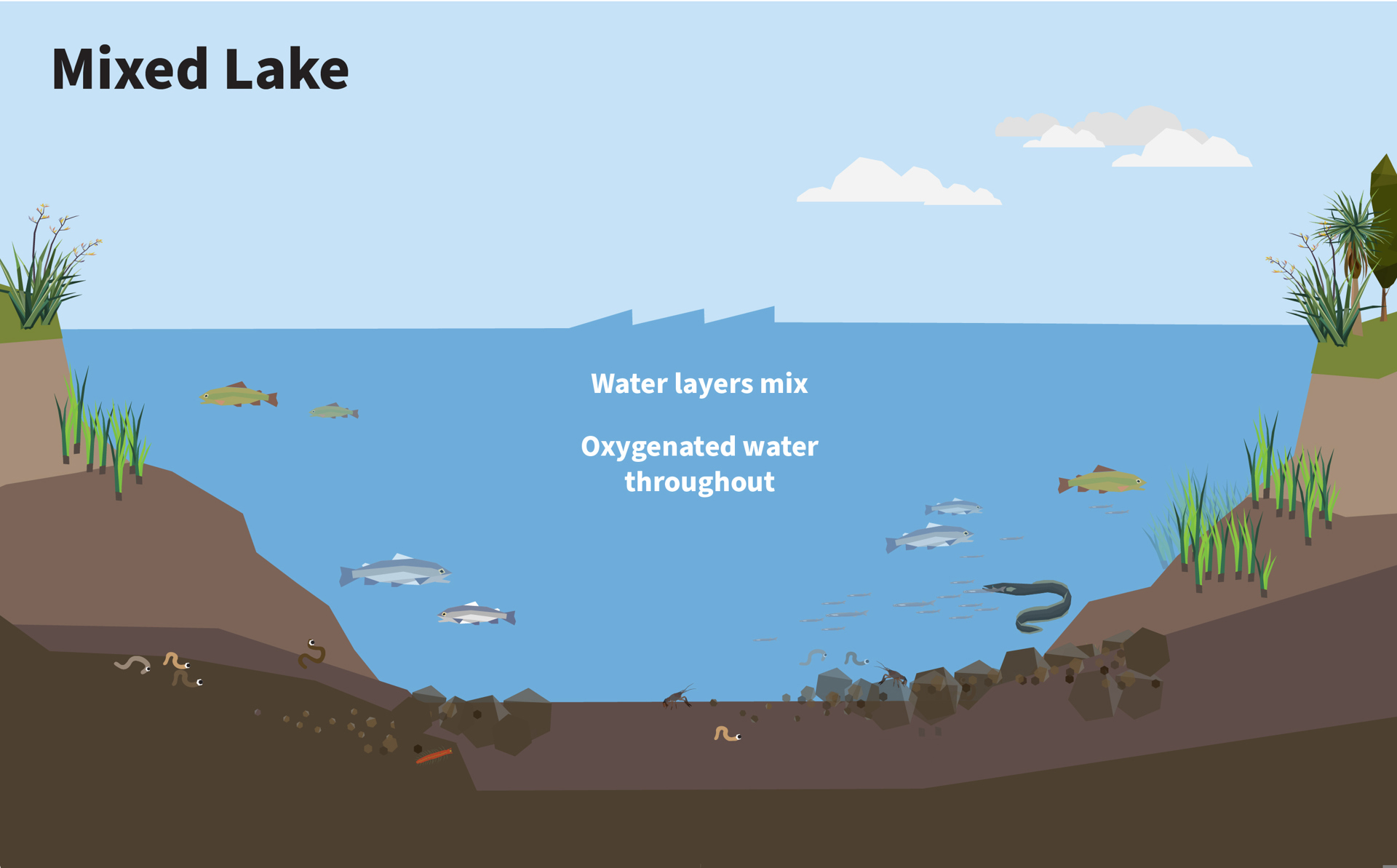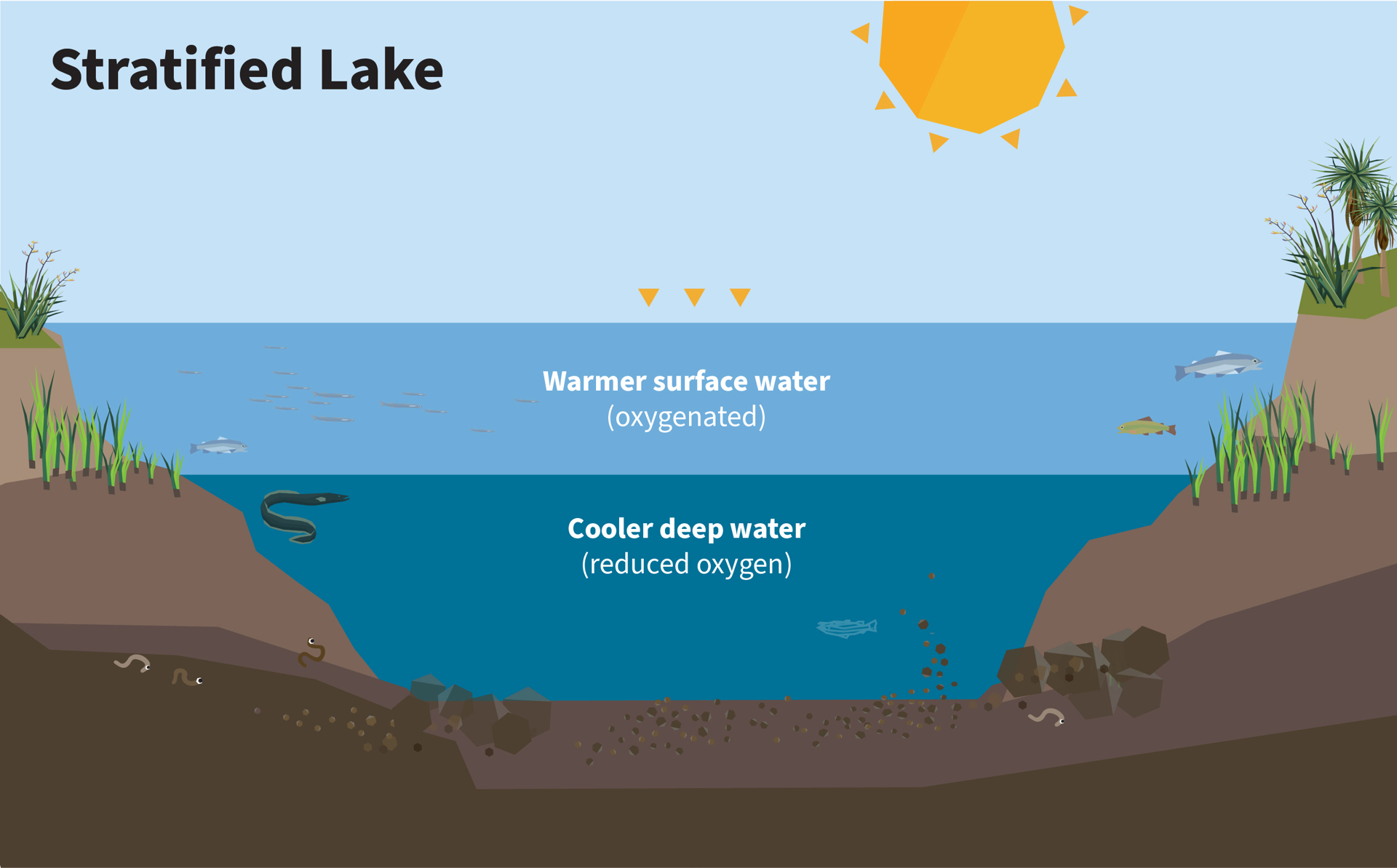New Zealand Lakes
Lakes are localised bodies of water that are surrounded by land. They may be fed by, or feed into rivers or may be maintained by rainfall and groundwater inputs. Lakes exist in all shapes and sizes and may be natural (for example formed by glaciation or landslides) or man-made (for example reservoirs created after a river is dammed).
Lakes are an important feature of New Zealand’s landscape. They provide a habitat for birds and fish, are highly valued culturally by Māori, and are used for a variety of recreational activities including rowing, fishing, swimming and boating. Lakes provide a key source of municipal water supply for many towns and cities throughout the country and they act as natural nutrient sinks for run-off from the land. New Zealand’s deepest lake is Lake Hauroko (462 m), and the largest is Lake Taupo (622 km2).
How do we monitor the health of our lakes?
LAWA displays a range of lake health indicators: Trophic Level Index (TLI), Lake Submerged Plant Indicators (LakeSPI, Native Condition Index and Invasive Impact Index), and water quality indicators: total phosphorus (TP), total nitrogen (TN), ammoniacal nitrogen, chlorophyll a, cyanobacteria, clarity (Secchi disc) and E. coli.
Trophic state of lakes
Nutrients such as nitrogen and phosphorus tend to be limiting resources in standing water bodies, so increased concentrations tend to result in increased plant growth. The ‘trophic state’ of a lake may be used to make a rough estimate of its biological productivity. There are three main classes of trophic state: oligotrophic, mesotrophic or eutrophic. Oligotrophic lakes are typically low in nutrients and are unproductive, mesotrophic lakes have moderate levels of nutrients and productivity, while eutrophic lakes exhibit excessive nutrient levels and high biological productivity. The Trophic Level Index (TLI) is used on LAWA to give an overall picture of the health of New Zealand lakes. See this factsheet on how TLI is calculated.
Lake ecological health
Invasive species, nutrient enrichment, changes in water clarity and fluctuations in water level all influence the health of the community of aquatic plants. Lake Submerged Plant Index (LakeSPI) is a method of characterising the ecological health of lakes based on the amount and distribution of native and invasive aquatic plants (macrophytes) growing in them. Higher LakeSPI scores are associated with better water quality. See this factsheet on for more information about LakeSPI.
Lake types
Lakes can be classified by how they are formed (geomorphic lake types) and by the mixing pattern of the water and how they are connected to the sea.
Geomorphic lake type
Lakes can form through various geomorphological processes or any process that creates depressions and rims in the landscape that catches and retains water. The origin of lakes in New Zealand is commonly classified based on Lowe and Green (1992):
- Aeolian lakes (or dune lakes) are often formed by wind-blown sand deposits and sand dunes.
- Peat lakes are created as a result of the accumulation of peat, although some lakes that are created by other processes have been modified by peat growth and can be considered peat lakes.
- Glacial lakes can be formed by combination of different processes, including ice-excavated rock depressions, glacial moraine, and depressions created by melting ice blocks in retreating glaciers.
- Landslide lakes are often created in valleys that are blocked by rock falls or avalanches and are commonly found in seismically active areas.
- Riverine lakes commonly form in water filled depressions on river floodplains as river channels migrate and avulse.
- Shoreline lakes (or barrier-bar lakes) are formed by long-shore drift of a barrier bar or spit across a coastal embayment near the sea and their water is commonly brackish.
- Volcanic, tectonic, and geothermal lakes are formed by various volcanic activities where some of the geological processes can act together. The latter lake type is often differentiated for other volcanic lakes due to direct active geothermal influence in the immediate catchment or within the lake.
- Dams (or artificial lakes, reservoirs) are contracted water bodies created by a barrage across a river valley. Their purposes differ and include hydropower generation and water storage for irrigation.
Mixing patterns
Lakes can be classified based on their thermal mixing regime and connectivity regime to the marine environment:
- In polymictic lakes, the water column remains mixed throughout the year. Most small, shallow lakes in New Zealand are polymictic.
- In stratified (or monomictic) lakes, mixing occurs only once a year. The water in these lakes usually stratifies into layers in summer and begins mixing in autumn. Most large, deep lakes in New Zealand are monomictic.
- Brackish lakes are coastal lakes which have a permanent or temporary connection to the sea. Salinity levels either consistently or temporarily exceed 0.5 psu.
- Intermittently Closing and Opening Lakes and Lagoons (or ICOLLs), are coastal or tidal lakes or lagoons that fill with freshwater until they breach a coastal barrier that results in rapid loss of freshwater from the lake or lagoon.
There is no agreed / fixed depth to define shallow and deep lakes in New Zealand. In terms of ecological function, the depth of the lake is not as informative as the geomorphic type or the mixing pattern. But lake depth is a useful way to split lakes into different categories when lakes are compared at a national scale. Shallower lakes are often polymictic and as depth increases the chances that the lake stratifies also increases. For the Lake Health National Picture we consider shallow and deep lakes.
Shallow Lakes
Shallow lakes (shallower than 10 metres deep) are often located in low elevations and in catchments with higher proportions of agriculture, urban or other development. They are generally well mixed throughout the year and can be very productive environments.
Deep Lakes
Deep lakes (deeper than 10 metres) are often located in upland catchments in New Zealand. They are often stratified in summer, meaning environmental conditions such as temperature and dissolved oxygen level change over the depth of the water column.
Lake stratification
Thermal stratification is a naturally occurring process where the lake separates into layers during warmer months (see figure below). When a lake is stratified, it usually forms three distinct layers: the epilimnion, the thermocline and the hypolimnion.
During stratification, upper warm water (epilimnion), which is less dense, will sit on top of colder, denser, deeper water (hypolimnion), creating two distinct layers that do not mix. The thermocline (or metalimnion) separates the top and the bottom layers. The thermocline is usually a thin but distinct layer, where temperature changes more rapidly with depth than it does in the layers above or below. The difference in water temperature (and thus water density) also prevents re-supply of oxygen to the bottom layer (hypolimnion). Organic matter decay and other processes at the lakebed use up oxygen. Therefore, during periods of stratification, oxygen is reduced in the bottom waters.
As winter approaches, the temperature of the surface water will drop. When the density of the cooling surface water is similar to the density of the deep water, the different layers start to mix (a process known as ‘overturn’) This process is often aided by wind, inflow floods and/or other processes (e.g., currents) that agitate the water.


Many lakes are naturally stratified. During periods of stratification, oxygen is reduced in the bottom waters, which can result in stress on aquatic species such as kākahi (freshwater mussels), kōura (freshwater crayfish) or fish. The higher the amount of organic matter (including decaying algae) in the lake, the higher the oxygen demand and the faster the oxygen gets used up. Therefore, nutrient enriched, highly productive lakes usually have faster and more severe oxygen reduction when they stratify than clear, unproductive (i.e. low nutrient, low algae) lakes. Low oxygen can also cause a release of nutrients that are stored in lakebed sediments. This process, called internal loading can increase the potential for nutrient enrichment and production of algae in the lake.
An increase in the stability and duration of stratification in lakes has been observed across New Zealand lakes in recent decades (Verburg et al., 2010). The length and stability of stratification has major effects on lake ecology through determining the availability of light, nutrients and oxygen to organisms.
Where do I find more information?
Burns, N., G. Bryers, & E. Bowman 2000. Protocol for monitoring the trophic status of New Zealand lakes and reservoirs. Prepared for NZ Ministry for the Environment. Lakes Consulting Ltd. 190 p.
Clayton J., Edwards, T. A method for monitoring ecological condition in New Zealand lakes. LakeSPI. User manual Version 2. National Institute of Water & Atmospheric Research Ltd. CRBV062
Jolly V.H. & J.M.A Brown 1975. New Zealand Lakes. Auckland University Press, New Zealand. 388p.
Lowe, D.J. & J.D. Green 1992. Lakes. In: Soons, J.M. & Selby, M.J. (eds.), Landforms of New Zealand. Longman Paul, Auckland.
Madden, C., K. Goodin, B. Allee, M. Finkbeiner, & D. Bamford 2008. Coastal and Marine Ecological Classification Standard. NOAA and Nature-Serve. 77p.
Verburg, P., Hamill, K., Unwin, M., & Abell, J. 2010. Lake water quality in New Zealand 2010: Status and trends. NIWA Client report for the Ministry for the Environment. NIWA Client report number: HAM2010-107
